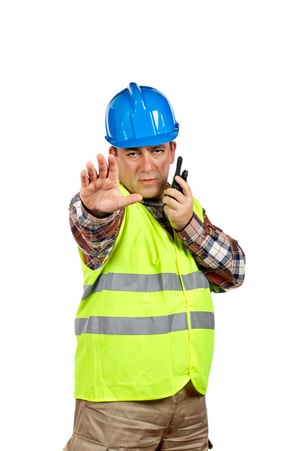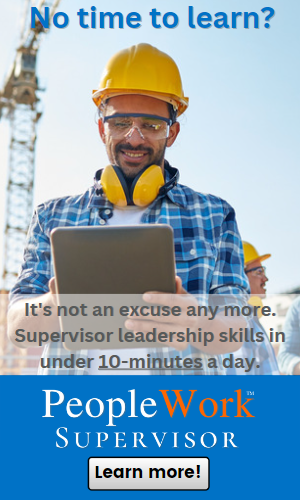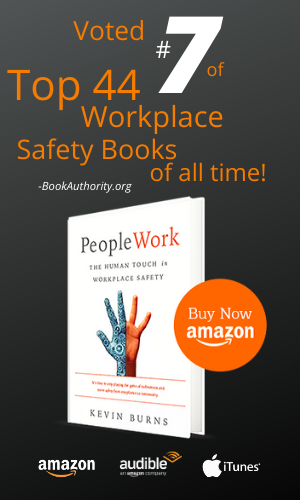Want to fix safety? Stop focusing on safety.
The Safety Double-Down
 When safety performance suffers, or complacency starts to sneak in, the typical response is to double-down on more safety. Increased attention on rules, procedures, meetings, reminders, inspections, audits. Maybe you see more generic safety posters, hear more safety shares, and sit through a video message from senior management.
When safety performance suffers, or complacency starts to sneak in, the typical response is to double-down on more safety. Increased attention on rules, procedures, meetings, reminders, inspections, audits. Maybe you see more generic safety posters, hear more safety shares, and sit through a video message from senior management.
It becomes pretty apparent that there is a push on for increased safety awareness.
And maybe it works … for a while. Then, life hits you: project deadlines, customer demands, production delays, weather issues, staffing problems. What is considered important (safety) gets nudged out of prime mindspace in favor of the urgent issues. And before long, you are back to dealing with the same safety performance issues you had before.
Traditional thinking has you convinced that you must double-down on safety. Except you don’t need more safety.
Instead, you need more people to buy-in to safety.
Five Steps to Getting Safety Buy-in At All Levels
To achieve better safety buy-in at all levels of the organization requires a very different approach than simply doubling-down on safety. It takes a coordinated effort to shift the thinking throughout the organization.
Most importantly, it takes a clear understanding of the five levels and the key people who can turn safety performance around. And it may not come from the safety department.
1. Employees
You need more of your employees to buy-in to the benefits of safety. There has to be something that they get out of embracing safety (remember, not getting hurt is not a benefit. That’s what they’re supposed to do.)
At the same time, employees must commit to teamwork, and quality, and being proud of the work they do. And especially looking out for each other. You can’t achieve a high-quality performance reputation by engaging in low-quality safety standards.
Employees want to feel proud of the work they do, the way they do it (safely), and the people they do it with (co-workers). Employees need to feel that their contribution matters.
2. Supervisors
 You need more supervisors to buy-in to embracing active caring.
You need more supervisors to buy-in to embracing active caring.
Supervisors must demonstrate that they openly care about the people on their teams. To guide them, coach them, and empower them. To make them feel like the work means more than just a paycheck. To make their team members feel like they are part of something special and that each member of the team has value. After all, “valued people value safety.” (David Broadhurst)
No one has more of an influence on safety at the frontlines than the example of the supervisor. And employees will do what supervisors do. It is imperative that supervisors buy-in to safety and lead by example.
3. Middle Managers
You need more middle managers to buy-in to mentoring and supporting their front-line supervisors. Mid-managers must have regular conversations with supervisors. They need to ask questions, listen to answers and hear what is really being said. Then, middle-managers can lead by example to demonstrate how morale and teamwork can improve.
For mid-managers, mentoring others brings great meaning to your own work. And at the same time, middle managers are helping frontline supervisors feel supported in their work.
Mentoring of supervisors builds their confidence and helps frontline teams succeed which results in better morale. That better morale shows up in the relationship between frontline supervisors and their teams.
4. Senior Managers
You need more senior managers to buy-in to providing the right resources to frontline supervisors and employees. That doesn’t mean unlimited budgets and new equipment for everyone. But it does mean getting supervisors the communication and management tools they need.
Can you think of one thing that supervisors need to do more than communicate? Do they have the skills and tools to do it effectively?
Executives must understand that at the front-line, supervisors have far more influence over both day-to-day activities and employees than executives. And if leadership really wants the company to become an employer of choice, then they must ensure that the relationships between supervisors and employees are maximized.
Supervisor-to-employee is the most important relationship in the organization.
5. Communications
 Then, you need more companies to accept that communications and messaging internally is the lifeblood of the organization. That without clear and effective communications, yours is likely to end up yet another in long line of workplaces that suffer the effects of poor communications.
Then, you need more companies to accept that communications and messaging internally is the lifeblood of the organization. That without clear and effective communications, yours is likely to end up yet another in long line of workplaces that suffer the effects of poor communications.
You cannot afford to be repeating yourselves and constantly correcting misinformation. That can cost thousands of hours of time and millions of dollars.
You need to ensure that your communications strategy includes how you are going to use safety to rally your team and get everyone on the same page. And, that includes the most important communications of all, the communications between frontline supervisor and frontline employee.
Your Key People Are At The Frontline
To shift the how we do things 'round here way of operating, support and resources need to make their way to the frontlines first. Training, expertise, strategy, confidence-building.
The frontlines are where the largest numbers of employees gather each day. It’s where the greatest number of supervisors do their jobs, where the greatest amount of activity is. It’s where the most problems happen and where the largest numbers of safety incidents occur.
At the frontline is where the morale and reputation of the organization is created and upheld. It’s at the frontline where supervisory tools, skills, and training are most needed.
A disgruntled employee rarely leaves a company. They leave a poorly performing supervisor.
Supervisors need better skills, tools and resources if they are going to fulfill their roles as influencers of morale, teamwork and safety.
When communications, morale, and supervisory struggles, so does safety performance. You can't fix safety if you don't first fix the other issues. But once the other issues are addressed, you will find safety performance follows.
Safety isn't a thing you do. It's a result you get when everyone in the organization is doing the right things.
Start at the root cause of safety performance issues. It's not safety. You don’t need more safety. You need more of your people to buy-in to what needs doing to make theirs a rewarding and safe workplace.
--
Take a look at the Safety Communications & Coaching for Supervisors Program for your organization. It's a 12-week program that includes training, mentoring, and the skills and tools to be more effective in any supervisory role.
 --
--
Kevin Burns is the President/CEO of KevBurns Learning. Kevin works with smart, caring companies to energize safety culture, build teamwork, and get employee buy-in.
--
In 2020, BookAuthority.org named PeopleWork #7 of The Top 44 Workplace Safety Books of All Time. Buy yourself a copy of PeopleWork: The Human Touch in Workplace Safety and give another as a gift to a colleague.
--
Subscribe to Kevin’s Blog.


